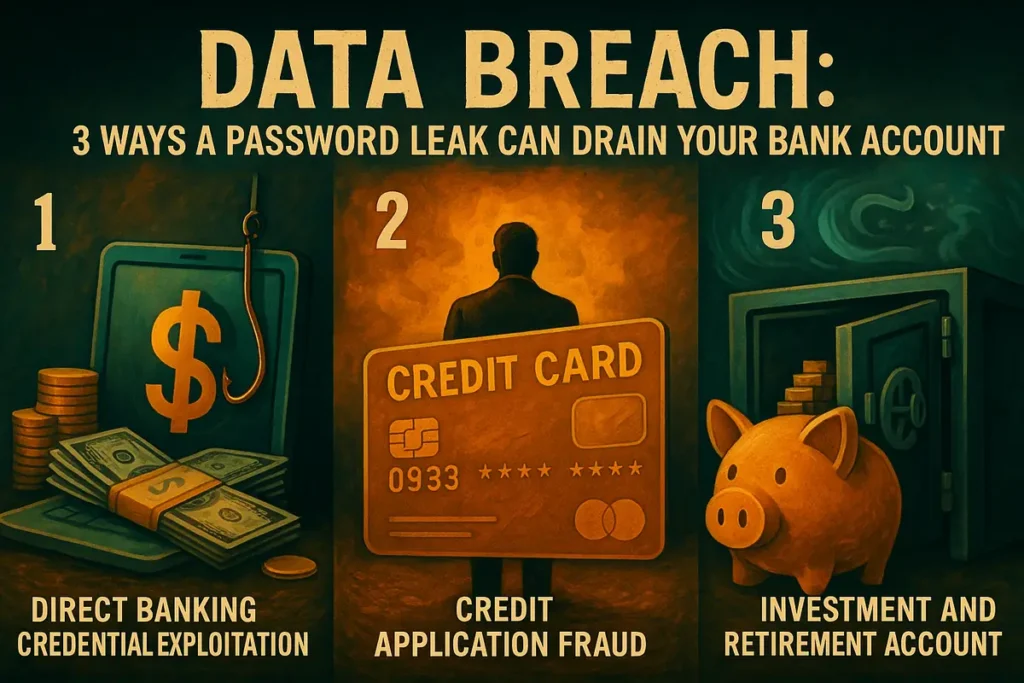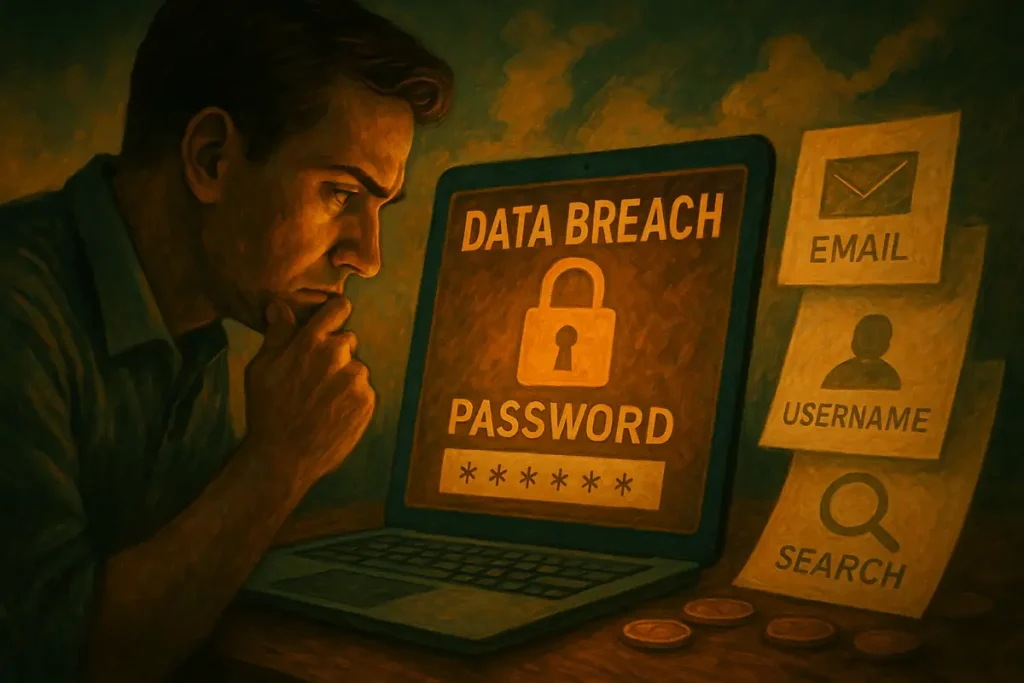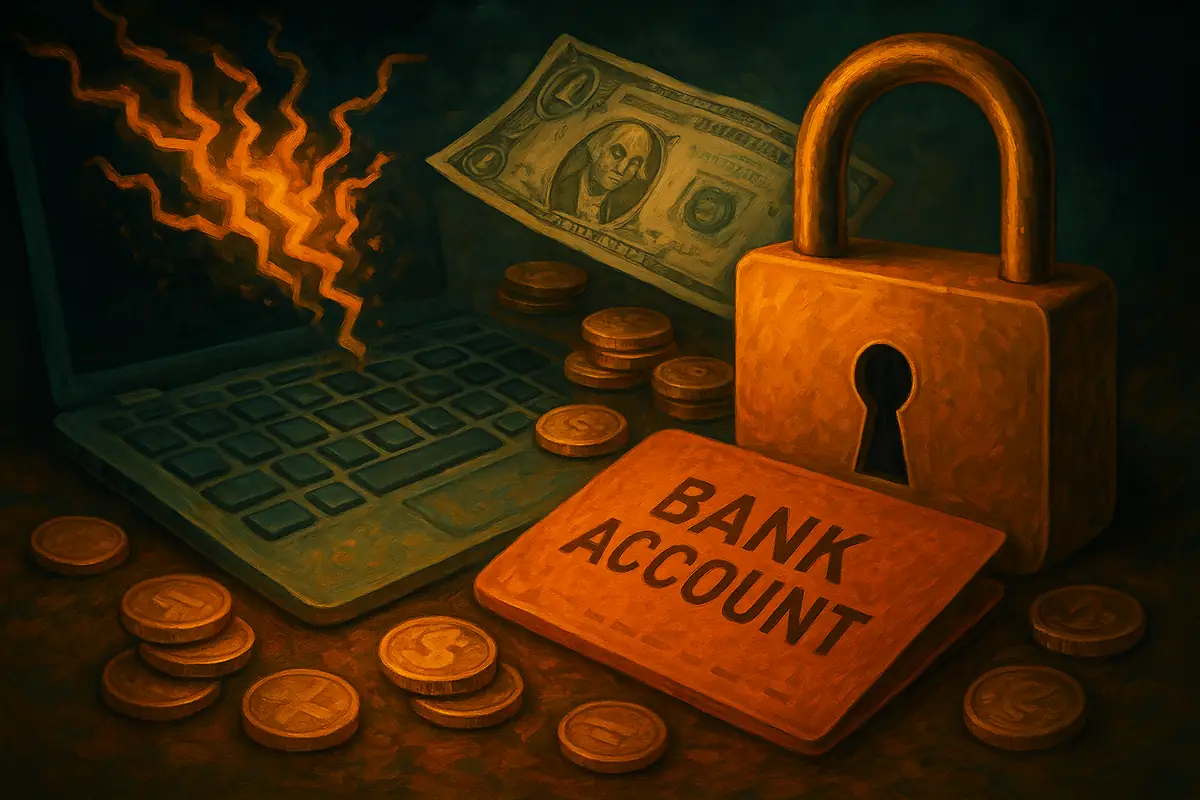Introduction
Your morning coffee routine was interrupted by an urgent email: “Suspicious activity detected on your account.” Sound familiar? You’re not alone. According to the FBI’s 2024 Internet Crime Complaint Center report, Americans reported losses exceeding $16 billion from cybercrime—a 33% increase from 2023, and the average victim loss reached approximately $19,372. When hackers obtain your passwords through data breaches, they don’t just access your social media—they target your most valuable asset: your money.
As a financial security expert who has helped thousands of Americans protect their wealth from cyber threats, I’ve witnessed firsthand how a single password leak can transform from a minor inconvenience into a devastating financial disaster. The harsh reality? Most people don’t realize their compromised credentials are being sold on dark web marketplaces for as little as $5, giving criminals direct access to drain bank accounts, open fraudulent credit lines, and destroy credit scores.
This comprehensive guide reveals the three primary ways data breach incidents lead to significant financial losses, provides actionable protection strategies, and shows you exactly how to safeguard your hard-earned money from password-related security threats. You’ll learn practical steps to identify if your information has been compromised and implement bank-grade security measures that cost nothing but could save you thousands.
⚠️ Important Note: This article is for educational and informational purposes only and does NOT constitute financial advice. Always consult with a qualified professional for your specific situation. Investments involve risk. This content reflects our views and experience, not a recommendation.
As an Amazon Associate and affiliate of other programs, we may earn qualifying commissions from links in this article at no additional cost to you. Read our Full Disclaimer and Privacy Policy.
What you read here:
How Do Data Breaches Actually Happen and Why Should You Care?
Data breaches occur when cybercriminals gain unauthorized access to company databases containing customer information, including usernames, passwords, email addresses, and often financial details. Major corporations like Equifax, Target, and Capital One have all experienced massive breaches affecting millions of Americans, proving that no organization is immune.
The process typically unfolds in three stages: initial infiltration through phishing emails or system vulnerabilities, lateral movement within networks to access sensitive databases, and finally, data extraction and sale on underground marketplaces. What makes these password leaks particularly dangerous is the speed at which stolen credentials are monetized—often within hours of the breach.
Your personal data doesn’t stay private for long. Cybersecurity researchers have documented how password breach information appears on dark web forums within 24-48 hours, complete with tutorials on how to use the stolen credentials for financial fraud. The average cost of a complete identity profile on these marketplaces ranges from $15 to $40, making financial fraud incredibly accessible to criminals.
Modern data breach passwords are often stored in hashed formats, but sophisticated attackers use advanced cracking techniques to decode them. Even if your password appears secure, weak hashing algorithms or poor security practices by companies can expose your credentials within days. This is why understanding your vulnerability is crucial for protecting your financial future.
What Are the Three Primary Ways Password Leaks Drain Your Bank Account?

Method 1: Direct Banking Credential Exploitation
When hackers obtain your banking passwords through data breaches, they immediately attempt to access your accounts using automated tools that can try thousands of login combinations per minute. If you’ve reused the same password across multiple platforms, they can often gain direct access to your checking, savings, and investment accounts.
Once inside your banking portal, criminals work quickly to transfer funds to untraceable accounts, often using peer-to-peer payment services or cryptocurrency exchanges. They may also set up automatic payments to accounts they control, ensuring continuous access to your money even after you discover the breach.
The sophistication of these attacks has evolved dramatically. Modern fraudsters use your legitimate banking history to make transfers appear normal, timing large withdrawals to coincide with your typical spending patterns. They may also modify your contact information to prevent you from receiving fraud alerts, buying themselves additional time to drain your accounts.
Method 2: Credit Application Fraud Using Leaked Personal Information
Password leaks rarely contain just passwords—they often include comprehensive personal profiles with Social Security numbers, addresses, employment information, and financial details. Armed with this data, criminals can open new credit cards, personal loans, and even mortgages in your name without your knowledge.
The financial impact extends far beyond immediate theft. Fraudulent accounts damage your credit score, making it difficult to secure legitimate loans for homes, cars, or business ventures. The average victim spends 200+ hours and over $1,400 resolving identity theft issues, not including lost wages from time off work.
Credit application fraud is particularly insidious because it can remain undetected for months. By the time you discover unauthorized accounts, criminals may have maxed out credit lines, defaulted on payments, and severely damaged your financial reputation. The cleanup process can take years and significantly impact your ability to achieve financial goals.
Method 3: Investment and Retirement Account Takeovers
High-net-worth individuals face additional risks when data breach incidents expose their investment account credentials. Criminals target 401(k) accounts, IRAs, and brokerage platforms, where they can liquidate investments, trigger massive tax penalties, and steal funds intended for retirement.
These attacks are particularly devastating because retirement account theft often goes unnoticed for extended periods. Many people check investment accounts less frequently than banking accounts, giving criminals months to systematically drain portfolios. The tax implications alone can cost victims tens of thousands of dollars in penalties and lost retirement savings timeline.
Sophisticated attackers also use compromised investment accounts to manipulate stock prices through coordinated buying and selling, profiting from market volatility they create. This level of financial crime requires substantial resources to investigate and prosecute, meaning many victims never recover their losses.
How Can You Tell If Your Passwords Have Been Compromised in a Data Breach?

Identifying password leak exposure requires proactive monitoring using specialized tools and services designed to track credential compromises across the internet. The most reliable method involves using legitimate breach notification services like HaveIBeenPwned, which maintains databases of confirmed data breaches and allows you to check if your email addresses or usernames appear in known incidents. Or using the official government service IdentityTheft.gov/databreach.
Your financial institutions often provide early warning systems, but these typically activate only after fraudulent activity begins. More effective approaches include setting up Google Alerts for your name combined with terms like “data breach” or “password leak,” monitoring your credit reports monthly for unauthorized accounts, and reviewing bank statements weekly for suspicious transactions.
Professional identity monitoring services offer comprehensive protection by scanning dark web marketplaces for your personal information, but free alternatives can provide adequate protection for most individuals. The key is establishing multiple monitoring layers rather than relying on single detection methods.
| Detection Method | Cost | Detection Speed | Accuracy Rate | Best For |
|---|---|---|---|---|
| HaveIBeenPwned | Free | 1-30 days | 95% | Email-based breaches |
| Credit Monitoring | $10-25/month | Real-time | 90% | New account fraud |
| Bank Alerts | Free | Immediate | 85% | Transaction monitoring |
| Identity Monitoring | $15-30/month | 1-7 days | 92% | Comprehensive protection |
Watch for subtle signs that often precede major financial fraud: unexpected password reset emails, slower than normal account loading times, small unauthorized transactions (often used to test account access), and changes to your account settings you didn’t make. Criminals frequently test compromised accounts with minimal activity before launching major theft operations.
What Immediate Steps Should You Take After Discovering a Password Breach?
Time is critical when responding to data breach exposure. Your first priority should be changing passwords on all financial accounts, starting with banks, credit cards, and investment platforms. Use unique, complex passwords for each account—never reuse credentials across multiple financial services.
Contact your financial institutions immediately to report potential compromise, even if you haven’t detected fraudulent activity. Most banks can place temporary holds on accounts, issue new cards, and implement additional security measures while you secure your other accounts. Document all communications with timestamps and reference numbers for insurance and legal purposes.
Here’s your immediate action checklist:
- Change all financial account passwords within 2 hours
- Enable two-factor authentication on every account
- Place fraud alerts with all three credit bureaus** (learn how at FTC.gov)
- Review and download recent statements from all accounts
- Contact banks to discuss temporary account restrictions
- Set up account monitoring alerts for all transactions
- Consider freezing your credit reports temporarily
Simultaneously, begin monitoring for indirect signs of credential abuse. Check your email for password reset requests, review your phone bill for unusual charges that might indicate SIM card swapping attempts, and verify that your mailing address hasn’t been changed on any accounts.
[IMAGE 1: Insert professional infographic showing a timeline of breach response actions with clock icons, using blue and green colors to convey trust and security, including specific hour markers for each critical step]
How Do You Build Long-Term Protection Against Future Data Breaches?
Creating robust defense against password leaks requires implementing multiple security layers that work together to protect your financial assets. The foundation involves using unique, complex passwords for every account, managed through reputable password management software that generates and stores credentials securely.
Two-factor authentication represents your most powerful defense against credential-based attacks. Even if criminals obtain your passwords through data breaches, they cannot access accounts protected by authenticator apps or hardware security keys. Financial institutions increasingly offer advanced authentication options, including biometric verification and device-based tokens.
Your long-term strategy should include:
- Password Management: Use tools like Bitwarden or 1Password to generate unique 16+ character passwords
- Multi-Factor Authentication: Implement app-based or hardware authentication on all financial accounts
- Regular Security Audits: Monthly reviews of account activity and security settings
- Credit Monitoring: Continuous monitoring of credit reports and scores
- Secure Communication: Use encrypted email and messaging for financial communications
- Device Security: Keep all devices updated with latest security patches
- Network Protection: Use VPNs for banking on public Wi-Fi networks
Consider upgrading to premium banking tiers that offer enhanced fraud protection, identity theft insurance, and dedicated customer service for security issues. While these services cost more, the additional protection often pays for itself by preventing or quickly resolving security incidents.
Investment in cybersecurity education also provides long-term value. Understanding current fraud techniques, recognizing phishing attempts, and staying informed about emerging threats helps you avoid becoming a victim of future data breach incidents.
Which Financial Accounts Need the Highest Priority Protection?
Not all accounts carry equal risk or potential for financial damage. Prioritizing your security efforts based on account value and vulnerability ensures you protect your most critical assets first. Data breach criminals typically target accounts in a specific order based on ease of access and potential profit.
Your primary protection priorities should follow this hierarchy:
Tier 1 – Critical Protection (Immediate Action Required):
- Primary checking and savings accounts
- Credit cards with high limits
- Investment and retirement accounts
- Business banking accounts
- Mortgage and loan servicer accounts
Tier 2 – High Protection (Secure Within 24 Hours):
- Secondary bank accounts
- PayPal and digital payment platforms
- Cryptocurrency exchange accounts
- Insurance company portals
- Tax preparation software accounts
Tier 3 – Standard Protection (Secure Within 1 Week):
- Loyalty program accounts with stored payment methods
- Subscription services with automatic billing
- Online shopping accounts with saved payment information
- Social media accounts (often used for password reset)
Focus your strongest security measures on Tier 1 accounts, implementing unique passwords, multi-factor authentication, and regular monitoring. These accounts typically contain the most money and offer criminals the greatest opportunities for quick profit from password leak exploitation.
[IMAGE 2: Insert pyramid-style diagram showing the three tiers of account protection priority, using professional colors like navy blue and gold, with dollar signs and shield icons to represent value and security levels]
| Account Type | Average Fraud Loss | Recovery Time | Credit Impact | Priority Level |
|---|---|---|---|---|
| Bank Accounts | $2,500 | 7-14 days | Low | Tier 1 |
| Credit Cards | $1,800 | 3-7 days | Medium | Tier 1 |
| Investment Accounts | $12,000 | 30-90 days | Low | Tier 1 |
| Digital Wallets | $800 | 1-3 days | Low | Tier 2 |
| Shopping Accounts | $400 | 1-7 days | Medium | Tier 3 |
Conclusion
Data breaches and password leaks represent one of the most significant threats to your financial security in 2025, but understanding these risks empowers you to take decisive action. The three primary attack vectors—direct banking credential exploitation, credit application fraud, and investment account takeovers—each require specific protective measures that go far beyond simply changing passwords.
Your financial future depends on implementing comprehensive security strategies that include unique passwords, multi-factor authentication, continuous monitoring, and rapid response protocols. The statistics are clear: Americans who proactively protect against data breach threats save an average of $3,400 annually compared to those who react only after experiencing fraud.
Remember that cybersecurity is an ongoing process, not a one-time fix. Regular security audits, staying informed about emerging threats, and maintaining strong relationships with your financial institutions create multiple layers of protection that make successful attacks increasingly difficult.
Take action today by implementing the strategies outlined in this guide, starting with your highest-priority financial accounts. Your future self will thank you for the time and effort invested in protecting your hard-earned wealth from the growing threat of cybercrime.
For comprehensive tools and strategies to strengthen your overall financial security, including advanced protection techniques and recommended security software, visit our detailed guide on the Best Fintech Tools for Personal Finance. These resources will help you build a complete financial security ecosystem that protects your wealth while optimizing your money management strategies.
FAQ – Data Breach & Financial Security
1. How can a data breach lead to my bank account being drained?
When hackers obtain your banking passwords through a data breach, they can access your accounts and transfer funds, set up automatic withdrawals, or even prevent you from receiving fraud alerts. If you reuse passwords, the risk increases dramatically.
2. What should I do immediately after a password leak?
Change your financial account passwords immediately, enable two-factor authentication, contact your banks, and set up fraud alerts. Acting within the first 2 hours significantly reduces potential financial loss.
3. How can I check if my passwords were exposed in a data breach?
You can use free tools like HaveIBeenPwned.com to check if your credentials appear in known breaches. Additionally, monitor your credit reports and bank statements regularly for suspicious activity.
4. Can leaked passwords damage my credit score?
Yes. Leaked credentials often include enough personal data for criminals to open credit cards or loans in your name. This can severely harm your credit score and take months or years to resolve.
5. Which financial accounts need the highest priority protection?
Your primary bank accounts, credit cards, investment portfolios, and mortgage or loan portals should be your top priority. These carry the highest financial impact if compromised.
6. Are my retirement and investment accounts safe after a breach?
Investment and retirement accounts are high-value targets and often overlooked. Hackers can liquidate your assets and leave you with tax penalties. Set up multi-factor authentication and monitor these accounts regularly.
7. How can I protect my finances from future password breaches?
Use a password manager, enable multi-factor authentication, and run monthly security audits. Combine this with credit monitoring and encrypted communication to build a long-term defense strategy.

Author: Michael holds an MBA in business management. He worked for 5 years as an investment consultant. He also works as a freelancer for a security company. He is the creator and writer of the finance article WalletWise.blog — where he shares practical tips and his experiences. His mission is to make the financial world simpler, more accessible and free of hidden fees.
Simple strategies, great results. Make your money count!




